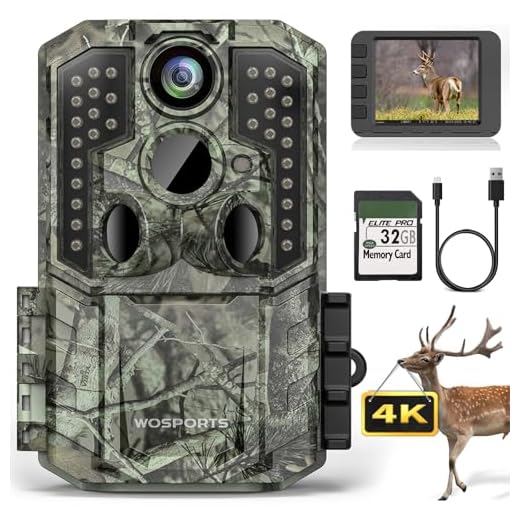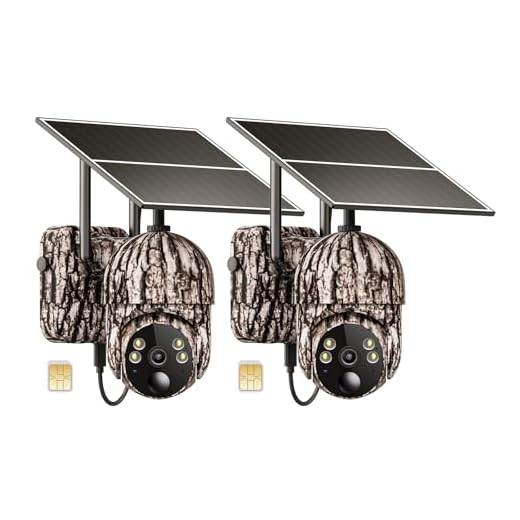




IR Security Cameras have become a popular tool for monitoring and securing properties. These cameras use infrared technology to capture images even in low light conditions, making them ideal for nighttime surveillance. However, some people wonder if these cameras can have unintended consequences when it comes to wildlife, particularly deer.
Deer are known for their skittish nature, and they can easily be spooked by unfamiliar sights and sounds. The question arises: do IR security cameras scare deer away? Some believe that the glowing infrared lights emitted by these cameras could startle deer and cause them to avoid the area where the cameras are installed.
On the other hand, supporters of IR security cameras argue that the infrared light is usually not visible to deer, as they see in a different range of light wavelengths than humans. They claim that deer are more likely to be scared off by the movement or noise associated with the cameras rather than the infrared light itself. So, do IR security cameras really scare deer? The debate continues.
Do Security Cameras Deter Deer?
Security cameras are often used to monitor and protect properties from intruders, but do they have any effect on deterring deer?
Deer are known to be wary of unfamiliar objects and sounds, so the presence of security cameras may initially startle them. However, deer are intelligent animals and can quickly adapt to their surroundings.
While security cameras may initially scare deer away, they are unlikely to serve as a long-term deterrent. Deer are more likely to become habituated to the presence of security cameras and return to the area once they realize there is no immediate threat.
Impact of Security Cameras on Deer Behavior
Security cameras can have a significant impact on deer behavior in their natural habitats. While deer are typically skittish animals, they can become accustomed to the presence of security cameras over time. Initially, the sudden appearance of a security camera may startle deer and cause them to be cautious. However, as they realize that the camera does not pose a threat, they may become more relaxed in its presence.
On the other hand, some deer may remain wary of security cameras and alter their behavior to avoid them. They may choose to avoid areas where cameras are placed or alter their feeding and movement patterns to minimize their exposure to the cameras. This can have an impact on the overall behavior and movement of deer populations in an area.
Overall, the impact of security cameras on deer behavior can vary depending on the individual deer and their level of exposure to the cameras. While some may become desensitized to the cameras, others may actively avoid them. Understanding how deer react to security cameras can help researchers and conservationists better manage and protect deer populations in different environments.
Benefits of Using Security Cameras to Prevent Deer Damage
Deer can cause significant damage to gardens, crops, and property, making them a nuisance for many homeowners. By installing security cameras on your property, you can effectively deter deer and prevent damage. Here are some key benefits of using security cameras to prevent deer damage:
1. Early Detection
Security cameras allow you to monitor your property 24/7, providing early detection of deer before they can cause any damage. With live feeds and motion detection capabilities, you can spot deer approaching your property and take action to scare them off before they can wreak havoc.
2. Deterrent Effect
Security cameras have a deterrent effect on deer, as they are more likely to avoid areas where they know they are being watched. The presence of cameras can make deer think twice before entering your property, reducing the likelihood of damage caused by their browsing and grazing.
Overall, using security cameras to prevent deer damage can help you protect your property and maintain a peaceful coexistence with wildlife.
Factors That Influence Deer Response to Security Cameras
When it comes to deer response to security cameras, several factors can influence how deer react to these devices. Understanding these factors can help you determine the best placement and usage of security cameras to minimize disturbance to deer populations.
1. Location
The location of the security camera plays a significant role in how deer respond. Cameras placed in areas frequented by deer are more likely to startle them, while cameras placed in less-trafficked areas may have less of an impact. Consider the natural pathways and behavior of deer when deciding where to install security cameras.
2. Visibility
The visibility of the security camera can also affect how deer react. Cameras that are highly visible or have blinking lights may startle deer more than cameras that are discreetly placed. Consider camouflaging or hiding cameras to reduce their impact on deer behavior.
- Consider installing cameras in trees or using natural cover to conceal them
- Use trail cameras or other low-profile options to minimize visibility
By taking these factors into account, you can help reduce the potential impact of security cameras on deer behavior and ensure that your surveillance efforts are effective without causing undue stress to local wildlife.
Effectiveness of Security Cameras in Scaring Away Deer
Security cameras can be a useful tool in deterring deer from entering certain areas. The presence of security cameras can make deer feel uneasy and less likely to linger in a particular location. However, the effectiveness of security cameras in scaring away deer may vary depending on various factors.
Factors Affecting Effectiveness:
1. Location: Placing security cameras in strategic locations where deer are known to frequent can increase their effectiveness.
2. Type of Camera: High-quality cameras with clear images and night vision capabilities are more likely to scare off deer.
3. Sound and Motion: Some security cameras come equipped with sound or motion sensors that can startle deer and prompt them to leave the area.
It is important to note that while security cameras can be a helpful deterrent, they may not always be 100% effective in scaring away deer. It is recommended to use a combination of methods, such as fencing, repellents, and noise-makers, for optimal deer control.
Case Studies on the Use of Security Cameras for Deer Control
Security cameras are increasingly being used to monitor and control deer populations in various locations. Here are some case studies highlighting the effectiveness of security cameras in deer management:
Case Study 1: Forest Reserve
In a forest reserve in the Midwest, security cameras were strategically placed to monitor deer activity. The cameras detected deer movement patterns and helped park rangers identify high-traffic areas. By analyzing the data collected from the cameras, park officials were able to implement targeted control measures to reduce deer damage to vegetation and minimize conflicts with visitors.
Case Study 2: Agricultural Area
In an agricultural area in the South, farmers installed security cameras to protect their crops from deer damage. The cameras were set up along the perimeter of the fields and triggered alarms when deer were detected. This real-time monitoring allowed farmers to respond quickly and deter deer from entering the fields, saving valuable crops from destruction.
| Case Study | Location | Outcome |
|---|---|---|
| Forest Reserve | Midwest | Reduced deer damage to vegetation |
| Agricultural Area | South | Protected crops from deer damage |
Comparison of Different Types of Security Cameras for Deer Management
When it comes to managing deer populations, using security cameras can be a valuable tool. Different types of security cameras offer various features and benefits for monitoring deer activity in your area. Here are a few key factors to consider when choosing a security camera for deer management:
1. Resolution: High-resolution cameras can provide clear and detailed images of deer, allowing you to better track their movements and behavior.
2. Night Vision: Cameras with infrared or low-light capabilities are essential for monitoring deer activity during the night when they are most active.
3. Motion Detection: Cameras with motion detection technology can trigger recording when deer are in the vicinity, saving battery life and storage space.
4. Weather Resistance: Look for cameras that are weatherproof and can withstand the elements to ensure durability and longevity.
5. Wireless Connectivity: Wireless cameras offer easy installation and remote access to footage, making it convenient to monitor deer activity from anywhere.
By considering these factors, you can choose the right security camera to effectively manage deer populations in your area.
Tips for Proper Placement of Security Cameras to Repel Deer
When it comes to deterring deer with security cameras, proper placement is key. Here are some tips to help you effectively repel deer from your property:
1. Strategic Positioning
Place your security cameras in strategic locations where deer are likely to enter your property. Focus on areas near food sources, such as gardens or bird feeders, as deer are attracted to these areas.
2. Height Matters
Mount your security cameras at a height that is out of reach for deer. This will not only provide a better vantage point for surveillance but also prevent deer from tampering with or damaging the cameras.
Deer Reactions to Infrared vs. Motion-Activated Security Cameras
Deer reactions to infrared and motion-activated security cameras can vary based on a few factors.
Infrared Cameras: These cameras emit a low-level light that is invisible to humans but can be detected by animals like deer. Some deer may notice the faint glow from the infrared lights and become cautious or spooked. However, others may not be bothered by it at all.
Overall, infrared cameras are less likely to startle deer compared to bright white-light cameras.
Motion-Activated Cameras: These cameras trigger recording or alerts when they detect motion. The sudden movement or noise from the camera activating may startle deer in the vicinity. They might flee or become more cautious in the area.
Deer are generally more sensitive to sudden movements, so motion-activated cameras could potentially scare them more than infrared cameras.
Ultimately, the reaction of deer to security cameras depends on the individual deer, their familiarity with human structures, and the specific circumstances of the camera setup.
Legal Considerations When Using Security Cameras for Deer Protection
When using security cameras to monitor and protect deer on your property, it is important to consider the legal implications of such surveillance. Here are some key legal considerations to keep in mind:
Privacy Laws
Before installing security cameras, it is essential to understand the privacy laws in your area. Make sure you are compliant with any regulations regarding surveillance on private property and the protection of individuals’ privacy rights.
Trespassing Laws
While security cameras can help deter trespassers and poachers, it is crucial to understand the laws surrounding trespassing on your property. Be aware of any restrictions on capturing images or videos of individuals without their consent.
Conclusion: By being aware of and complying with relevant legal considerations, you can use security cameras effectively to protect deer on your property while avoiding any legal issues.








